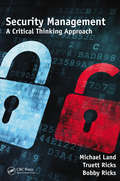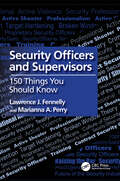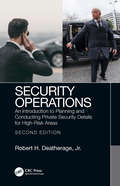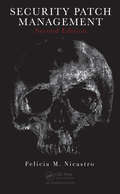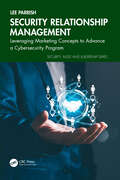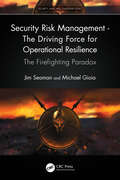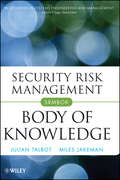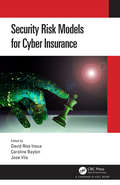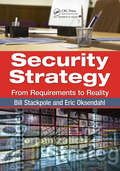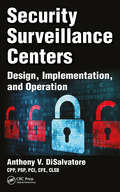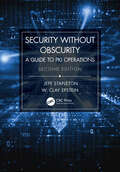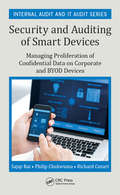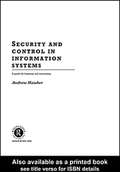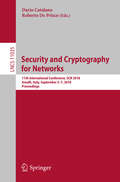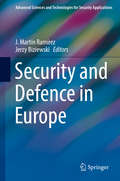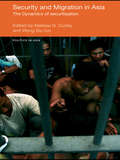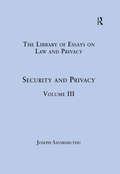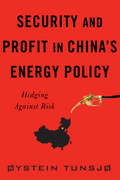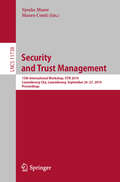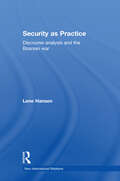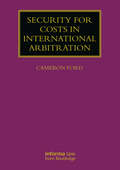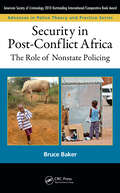- Table View
- List View
Security Management for Occupational Safety (Occupational Safety & Health Guide Series #15)
by Michael LandHow far would or should you go to feel secure? While everyone wants safety and security, the measures to achieve it are often viewed of as intrusive, unwanted, a hassle, and limiting to personal and professional freedoms. Yet, when an incident occurs, we can never have enough security. Security Management for Occupational Safety provides a framewor
Security Management: A Critical Thinking Approach
by Michael Land Truett Ricks Bobby RicksSecurity is a paradox. It is often viewed as intrusive, unwanted, a hassle, or something that limits personal, if not professional, freedoms. However, if we need security, we often feel as if we can never have enough. Security Management: A Critical Thinking Approach provides security professionals with the ability to critically examine their organ
Security Manager's Guide to Disasters: Managing Through Emergencies, Violence, and Other Workplace Threats
by Anthony D. ManleyTerrorist or criminal attack, fire emergency, civil or geographic disruption, or major electrical failure recent years have witnessed an increase in the number of natural disasters and man-made events that have threatened the livelihoods of businesses and organizations worldwide. Security Manager‘s Guide to Disasters: Managing Through Emergencies,
Security Officers and Supervisors: 150 Things You Should Know
by Lawrence J. Fennelly Marianna A. PerrySecurity Officers and Supervisors: 150 Things You Should Know presents an array of relevant topics, including addressing “Tips of the Trade” in how to manage a team of professionals and serve as an effective supervisor. This includes both keeping management informed of decisions, aligning policy, procedure, and training with business objectives, and hiring and managing a team of professionals to maintain continuity of operations and a safe, secure environment. There are many factors involved in managing a department and workforce and the book uses a handy-reference format to present the salient information, both concrete knowledge as well as the softer skills, required for managers to motivate individuals and lead teams to pull in the same direction.Short, easy-to-read chapters include lists of relevant definitions, some do’s and don’ts, best practices, emerging trends, and well as example case studies based upon the authors’ professional experience. The primary goal is to provide a foundation for readers to identify, comprehend, and apply management concepts and security principles in their own environments so that readers will be readily prepared to troubleshoot problems and overcome challenges.Building and leading a trusted team that can set and achieve clearly outlined objectives begins with leadership. Security Officers and Supervisors: 150 Things You Should Know outlines those principles and traits required for professionals to succeed when promoted (though, more often than not, thrust!) into a security supervisory role.
Security Operations: An Introduction to Planning and Conducting Private Security Details for High-Risk Areas
by Robert H. Deatherage, Jr.Security Operations: An Introduction to Planning and Conducting Private Security Details for High-Risk Areas, Second Edition was written for one primary purpose: to keep people alive by introducing them to private security detail tactics and techniques. The book provides an understanding of the basic concepts and rules that need to be followed in protective services, including what comprises good security practice. This second edition is fully updated to include new case scenarios, threat vectors, and new ambush ploys and attack tactics used by opportunistic predators and seasoned threat actors with ever-advanced, sophisticated schemes. Security has always been a necessity for conducting business operations in both low- and high-risk situations, regardless of the threat level in the operating environment. Overseas, those with new ideas or businesses can frequently be targets for both political and criminal threat agents intent on doing harm. Even in the United States, people become targets because of positions held, publicity, politics, economics, or other issues that cause unwanted attention to a person, their family, or business operations. Security Operations, Second Edition provides an introduction to what duties a security detail should perform and how to effectively carry out those duties. The book can be used by a person traveling with a single bodyguard or someone being moved by a full security detail. FEATURES • Identifies what can pose a threat, how to recognize threats, and where threats are most likely to be encountered • Presents individuals and companies with the security and preparedness tools to protect themselves when operating in various environments, especially in high-risk regions • Provides an understanding of operational security when in transit: to vary route selection and keep destinations and movement plans out of the public view • Outlines the tools and techniques needed for people to become security conscious and situationally aware for their own safety and the safety of those close to them An equal help to those just entering the protection business or people and companies that are considering hiring a security detail, Security Operations is a thorough, detailed, and responsible approach to this serious and often high-risk field. Robert H. Deatherage Jr. is a veteran Special Forces Soldier and private security consultant with thirty years’ experience in military and private security operations. His various writings on security topics cover security operations, threat assessment, risk management, client relations, surveillance detection, counter surveillance operations, foot and vehicle movements, and building security—blending solid operational theory with practical field experience.
Security Patch Management
by Felicia NicastroAlthough the patch management process is neither exceedingly technical nor extremely complicated, it is still perceived as a complex issue that's often left to the last minute or resolved with products that automate the task. Effective patch management is not about technology; it's about having a formal process in place that can deploy patches to v
Security Relationship Management: Leveraging Marketing Concepts to Advance a Cybersecurity Program (Security, Audit and Leadership Series)
by Lee ParrishAligning information security to the goals and strategies of the business is paramount for ensuring risks are addressed, without an abundance of negative impacts to the company. But how does a Chief Information Security Officer (CISO) accomplish effective alignment? A security executive must understand the detailed needs of business leaders and stakeholders from across all corners of the company. We cannot rely on a standard cadence of general security discussions across all of the lines of business, as well as functional areas, and expect our alignment to be maximally effective. Instead, we should promote our security programs in such a way that makes it personal to whomever we are speaking with at any given time.By leveraging already established and tested marketing concepts, slightly altered for information security, the CISO can tailor their message to fit the needs of each stakeholder. This allows for in-depth business alignment, as well as a holistic view of the company’s underpinnings for the CISO. Within these pages, the reader will learn how segmentation, the Four Ps, and customer relationship management techniques, can help to transform their security program. Additionally, the book introduces a concept called Security Relationship Management (SRM) that optimizes the creation and nurturing of the hundreds of professional relationships (within and outside the company) that a CISO must balance each week. Through structured tracking of interactions and analyzing SRM data, the CISO ensures that relationships are managed effectively, which increases alignment between the business and cybersecurity initiatives. Pick up your copy of Security Relationship Management: Leveraging Marketing Concepts to Advance a Cybersecurity Program, today to begin your SRM journey.Please visit www.novelsecurity.com for more information.
Security Risk Management - The Driving Force for Operational Resilience: The Firefighting Paradox (Security, Audit and Leadership Series)
by Jim Seaman Michael GioiaThe importance of businesses being ‘operationally resilient’ is becoming increasingly important, and a driving force behind whether an organization can ensure that its valuable business operations can ‘bounce back’ from or manage to evade impactful occurrences is its security risk management capabilities. In this book, we change the perspective on an organization’s operational resilience capabilities so that it shifts from being a reactive (tick box) approach to being proactive. The perspectives of every chapter in this book focus on risk profiles and how your business can reduce these profiles using effective mitigation measures. The book is divided into two sections: 1. Security Risk Management (SRM). All the components of security risk management contribute to your organization’s operational resilience capabilities, to help reduce your risks. • Reduce the probability/ likelihood. 2. Survive to Operate. If your SRM capabilities fail your organization, these are the components that are needed to allow you to quickly ‘bounce back.’ • Reduce the severity/ impact. Rather than looking at this from an operational resilience compliance capabilities aspect, we have written these to be agnostic of any specific operational resilience framework (e.g., CERT RMM, ISO 22316, SP 800- 160 Vol. 2 Rev. 1, etc.), with the idea of looking at operational resilience through a risk management lens instead. This book is not intended to replace these numerous operational resilience standards/ frameworks but, rather, has been designed to complement them by getting you to appreciate their value in helping to identify and mitigate your operational resilience risks. Unlike the cybersecurity or information security domains, operational resilience looks at risks from a business-oriented view, so that anything that might disrupt your essential business operations are risk-assessed and appropriate countermeasures identified and applied. Consequently, this book is not limited to cyberattacks or the loss of sensitive data but, instead, looks at things from a holistic business-based perspective.
Security Risk Management Body of Knowledge
by Julian Talbot Miles JakemanA framework for formalizing risk management thinking in today¿s complex business environment Security Risk Management Body of Knowledge details the security risk management process in a format that can easily be applied by executive managers and security risk management practitioners. Integrating knowledge, competencies, methodologies, and applications, it demonstrates how to document and incorporate best-practice concepts from a range of complementary disciplines. <P><P>Developed to align with International Standards for Risk Management such as ISO 31000 it enables professionals to apply security risk management (SRM) principles to specific areas of practice. Guidelines are provided for: Access Management; Business Continuity and Resilience; Command, Control, and Communications; Consequence Management and Business Continuity Management; Counter-Terrorism; Crime Prevention through Environmental Design; Crisis Management; Environmental Security; Events and Mass Gatherings; Executive Protection; Explosives and Bomb Threats; Home-Based Work; Human Rights and Security; Implementing Security Risk Management; Intellectual Property Protection; Intelligence Approach to SRM; Investigations and Root Cause Analysis; Maritime Security and Piracy; Mass Transport Security; Organizational Structure; Pandemics; Personal Protective Practices; Psych-ology of Security; Red Teaming and Scenario Modeling; Resilience and Critical Infrastructure Protection; Asset-, Function-, Project-, and Enterprise-Based Security Risk Assessment; Security Specifications and Postures; Security Training; Supply Chain Security; Transnational Security; and Travel Security. Security Risk Management Body of Knowledge is supported by a series of training courses, DVD seminars, tools, and templates. This is an indispensable resource for risk and security professional, students, executive management, and line managers with security responsibilities.
Security Risk Models for Cyber Insurance
by David Rios Insua Caroline Baylon Jose VilaTackling the cybersecurity challenge is a matter of survival for society at large. Cyber attacks are rapidly increasing in sophistication and magnitude—and in their destructive potential. New threats emerge regularly, the last few years having seen a ransomware boom and distributed denial-of-service attacks leveraging the Internet of Things. For organisations, the use of cybersecurity risk management is essential in order to manage these threats. Yet current frameworks have drawbacks which can lead to the suboptimal allocation of cybersecurity resources. Cyber insurance has been touted as part of the solution – based on the idea that insurers can incentivize companies to improve their cybersecurity by offering premium discounts – but cyber insurance levels remain limited. This is because companies have difficulty determining which cyber insurance products to purchase, and insurance companies struggle to accurately assess cyber risk and thus develop cyber insurance products. To deal with these challenges, this volume presents new models for cybersecurity risk management, partly based on the use of cyber insurance. It contains: A set of mathematical models for cybersecurity risk management, including (i) a model to assist companies in determining their optimal budget allocation between security products and cyber insurance and (ii) a model to assist insurers in designing cyber insurance products. The models use adversarial risk analysis to account for the behavior of threat actors (as well as the behavior of companies and insurers). To inform these models, we draw on psychological and behavioural economics studies of decision-making by individuals regarding cybersecurity and cyber insurance. We also draw on organizational decision-making studies involving cybersecurity and cyber insurance. Its theoretical and methodological findings will appeal to researchers across a wide range of cybersecurity-related disciplines including risk and decision analysis, analytics, technology management, actuarial sciences, behavioural sciences, and economics. The practical findings will help cybersecurity professionals and insurers enhance cybersecurity and cyber insurance, thus benefiting society as a whole. This book grew out of a two-year European Union-funded project under Horizons 2020, called CYBECO (Supporting Cyber Insurance from a Behavioral Choice Perspective).
Security Strategy: From Requirements to Reality
by Bill Stackpole Eric OksendahlClarifying the purpose and place of strategy in an information security program, this book explains how to select, develop, and deploy the security strategy best suited to your organization. It focuses on security strategy planning and execution to provide a comprehensive look at the structures and tools needed to build a security program that enables and enhances business processes. Divided into two parts, the first part considers business strategy and the second part details specific tactics that support the implementation of strategic planning initiatives, goals, and objectives.
Security Surveillance Centers: Design, Implementation, and Operation
by Anthony V. DiSalvatoreUnlike current books on the market that focus primarily on the technical aspects of surveillance and protection, Security Surveillance Centers: Design, Implementation, and Operation focuses on the operation of a security surveillance center. This text explains in detail the role of security surveillance, as well as the critical aspects of the design, implementation, and operation of security surveillance centers of all sizes. Step-by-step coverage of policy and procedures, as well as the inclusion of industry-specific operational forms, guarantee a practical, user-friendly text for all levels of readers. Intended for any individuals or organizations currently employing security surveillance systems, this book is an asset for all users, from trainees to supervisors, seeking to create a more secure environment for themselves and for others.
Security Without Obscurity: A Guide to PKI Operations
by Jeff Stapleton W. Clay EpsteinPublic Key Infrastructure (PKI) is an operational ecosystem that employs key management, cryptography, information technology (IT), information security (cybersecurity), policy and practices, legal matters (law, regulatory, contractual, privacy), and business rules (processes and procedures). A properly managed PKI requires all of these disparate disciplines to function together – coherently, efficiently, effectually, and successfully. Clearly defined roles and responsibilities, separation of duties, documentation, and communications are critical aspects for a successful operation. PKI is not just about certificates, rather it can be the technical foundation for the elusive "crypto-agility," which is the ability to manage cryptographic transitions. The second quantum revolution has begun, quantum computers are coming, and post-quantum cryptography (PQC) transitions will become PKI operation’s business as usual.
Security and Auditing of Smart Devices: Managing Proliferation of Confidential Data on Corporate and BYOD Devices (Security, Audit and Leadership Series)
by Sajay Rai Philip Chukwuma Richard CozartMost organizations have been caught off-guard with the proliferation of smart devices. The IT organization was comfortable supporting the Blackberry due to its ease of implementation and maintenance. But the use of Android and iOS smart devices have created a maintenance nightmare not only for the IT organization but for the IT auditors as well. This book will serve as a guide to IT and Audit professionals on how to manage, secure and audit smart device. It provides guidance on the handling of corporate devices and the Bring Your Own Devices (BYOD) smart devices.
Security and Control in Information Systems: A Guide for Business and Accounting (Textbooks In Information Systems Ser.)
by Andrew HawkerWith the advent of electronic commerce, and the increasing sophistication of the information systems used in business organizations, control and security have become key management issues. Responsibility for ensuring that controls are well designed and properly managed can no longer simply be delegated to the technical experts. It has become an area in which the whole management team needs to be involved. This comprehensive review, written for the business reader, includes coverage of recent developments in electronic commerce, as well as the more traditional systems found in many organizations, both large and small. Intended for any manager whose work depends on financial or other business information, it includes case studies, summaries and review questions, making it equally suitable as a source text for students of business studies at postgraduate or advanced level.
Security and Cryptography for Networks: 11th International Conference, SCN 2018, Amalfi, Italy, September 5–7, 2018, Proceedings (Lecture Notes in Computer Science #11035)
by Roberto De Prisco Dario CatalanoThis book constitutes the proceedings of the 11th International Conference on Security and Cryptography for Networks, SCN 2018, held in Amalfi, Italy, in September 2018.The 30 papers presented in this volume were carefully reviewed and selected from 66 submissions. They are organized in topical sections on signatures and watermarking; composability; encryption; multiparty computation; anonymity and zero knowledge; secret sharing and oblivious transfer; lattices and post quantum cryptography; obfuscation; two-party computation; and protocols.
Security and Defence in Europe (Advanced Sciences and Technologies for Security Applications)
by J. Martín Ramírez Jerzy BiziewskiThis book argues that security and defense have never been true priorities in the European Union, and have constantly been marginalized by the elites since the Soviet Union collapsed and the Warsaw Pact disintegrated. Despite the official rhetoric, only a few tangible results can be presented concerning the operational readiness of European forces, and the EU’s inability to act was proven during the crises in the Balkans, NATO has experienced similar problems, as the majority of its members are EU countries. Both organizations have declared their resolve concerning the security and defense of their nations and territories, but, unfortunately, little has been done to lend these statements credence. In this context, the book analyzes several aspects of EU security and defense, including: the EU – NATO relationship, common defense policy and strategy, common capability building, common understanding of strategic changes, common operational planning and centrally synchronized exercises based on operational planning, etc. The member states have helped to make EU/NATO effective organizations, but unfortunately their individual interests and priorities constitute real challenges. This aspect should be discussed and addressed by political and military elites, scholars, analysts, students and the general public alike.
Security and Migration in Asia: The Dynamics of Securitisation (Politics in Asia)
by Wong Siu-Lun Melissa CurleySecurity and Migration in Asia explores how various forms of unregulated and illegal forms of human movement within Asia and beyond the region have come to be treated as 'security' issues, and whether and how a 'securitization' framework enables a more effective response to them. The process and theory of 'securitization' and 'desecuritization' have been developed within the international relations literature by the so-call Copenhagen school scholars, including Barry Buzan and Ole Waever among others. The topics explored in this well- presented and engaging book cover geographic areas of China, Northeast Asia, Central Asia, the Russian Far East, Southeast Asia, and the Hong Kong SAR, and includes research on: human trafficking and people smuggling financing illegal migration and links to transnational organized crime regulated and unregulated labour migration the 'securitization' of illegal migration in sending, transit and receiving countries. This book provides compelling insights into contemporary forms of illegal migration, under conditions of globalization, and makes a contribution to the literature in international relations and migration studies.
Security and Privacy: Volume III (The Library of Essays on Law and Privacy #3)
by Joseph SavirimuthuDuring the last decade in particular the levels of critical engagement with the challenges posed for privacy by the new technologies have been on the rise. Many scholars have continued to explore the big themes in a manner which typifies the complex interplay between privacy, identity, security and surveillance. This level of engagement is both welcome and timely, particularly in a climate of growing public mistrust of State surveillance activities and business predisposition to monetize information relating to the online activities of users. This volume is informed by the range of discussions currently conducted at scholarly and policy levels. The essays illustrate the value of viewing privacy concerns not only in terms of the means by which information is communicated but also in terms of the political processes that are inevitably engaged and the institutional, regulatory and cultural contexts within which meanings regarding identity and security are constituted.
Security and Profit in China’s Energy Policy: Hedging Against Risk (Contemporary Asia in the World)
by Øystein TunsjøChina has developed sophisticated hedging strategies to insure against risks in the international petroleum market. It has managed a growing net oil import gap and supply disruptions by maintaining a favorable energy mix, pursuing overseas equity oil production, building a state-owned tanker fleet and strategic petroleum reserve, establishing cross-border pipelines, and diversifying its energy resources and routes.Though it cannot be "secured," China's energy security can be "insured" by marrying government concern with commercial initiatives. This book comprehensively analyzes China's domestic, global, maritime, and continental petroleum strategies and policies, establishing a new theoretical framework that captures the interrelationship between security and profit. Arguing that hedging is central to China's energy-security policy, this volume links government concerns about security of supply to energy companies' search for profits, and by drawing important distinctions between threats and risks, peacetime and wartime contingencies, and pipeline and seaborne energy-supply routes, the study shifts scholarly focus away from securing and toward insuring an adequate oil supply and from controlling toward managing any disruptions to the sea lines of communication. The book is the most detailed and accurate look to date at how China has hedged its energy bets and how its behavior fits a hedging pattern.
Security and Trust Management: 15th International Workshop, STM 2019, Luxembourg City, Luxembourg, September 26–27, 2019, Proceedings (Lecture Notes in Computer Science #11738)
by Sjouke Mauw Mauro ContiThis book constitutes the proceedings of the 15th International Workshop on Security and Trust Management, STM 2019, held in Luxembourg City, Luxembourg, in September 2019, and co-located with the 24th European Symposium Research in Computer Security, ESORICS 2019. The 9 full papers and 1 short paper were carefully reviewed and selected from 23 submissions. The papers present novel research on all theoretical and practical aspects of security and trust in ICTs.
Security as Practice: Discourse Analysis and the Bosnian War (New International Relations)
by Lene HansenThis important text offers a full and detailed account of how to use discourse analysis to study foreign policy. It provides a poststructuralist theory of the relationship between identity and foreign policy and an in-depth discussion of the methodology of discourse analysis. Part I offers a detailed discussion of the concept of identity, the intertextual relationship between official foreign policy discourse and oppositional and media discourses and of the importance of genres for authors' ability to establish themselves as having authority and knowledge. Lene Hansen devotes particular attention to methodology and provides explicit directions for how to build discourse analytical research designs Part II applies discourse analytical theory and methodology in a detailed analysis of the Western debate on the Bosnian war. This analysis includes a historical genealogy of the Western construction of the Balkans as well as readings of the official British and American policies, the debate in the House of Commons and the US Senate, Western media representations, academic debates and travel writing and autobiography. Providing an introduction to discourse analysis and critical perspectives on international relations, this book will be essential reading for students and scholars of international relations, discourse analysis and research methodology.
Security beyond the State
by Rita Abrahamsen Michael C. WilliamsAcross the globe, from mega-cities to isolated resource enclaves, the provision and governance of security takes place within assemblages that are de-territorialized in terms of actors, technologies, norms and discourses. They are embedded in a complex transnational architecture, defying conventional distinctions between public and private, global and local. Drawing on theories of globalization and late modernity, along with insights from criminology, political science and sociology, Security Beyond the State maps the emergence of the global private security sector and develops a novel analytical framework for understanding these global security assemblages. Through in-depth examinations of four African countries - Kenya, Nigeria, Sierra Leone and South Africa - it demonstrates how global security assemblages affect the distribution of social power, the dynamics of state stability, and the operations of the international political economy, with significant implications for who gets secured and how in a global era.
Security for Costs in International Arbitration (Lloyd's Arbitration Law Library)
by Cameron FordThis is the first and leading comprehensive guide to security for costs in international arbitration, including commercial and investment arbitration, providing a text which will be the key resource for those considering, making and ruling on applications for security for costs. It is the first and only work to consider the 40+ factors informing the discretion to award security for costs.The author begins with an introduction and description of the security of costs controversy in international arbitration, and then explains the developing approach of arbitral tribunals to applications for security for costs, with reference to decisions published by ICC and ASA, and statistics of LCIA and decisions of the UK courts when they had the power to grant security for costs in international arbitration. The book features an analysis of the reasons given for restricting security for costs in international commercial arbitration to ‘exceptional circumstances’ or similar. The author conveys discretionary factors taken into account by the courts and arbitral tribunals in considering applications for security for costs, special considerations for investor-state arbitrations, the correct approach to the exercise of the discretion, the manner of making and resisting applications, appropriate orders to be made on applications, and consequences of orders.This book is written for all arbitration practitioners around the world, including arbitrators ruling on applications. The work would be incidentally useful to litigation practitioners as it necessarily considers applications for security for costs in litigation.
Security in Post-Conflict Africa: The Role of Nonstate Policing (Advances in Police Theory and Practice)
by Bruce BakerPolicing is undergoing rapid change in Africa as a result of democratization, the commercialization of security, conflicts that disrupt policing services, and peace negotiations among former adversaries. These factors combined with the inability of Africa‘s state police to provide adequate protection have resulted in the continuing popularity of va

